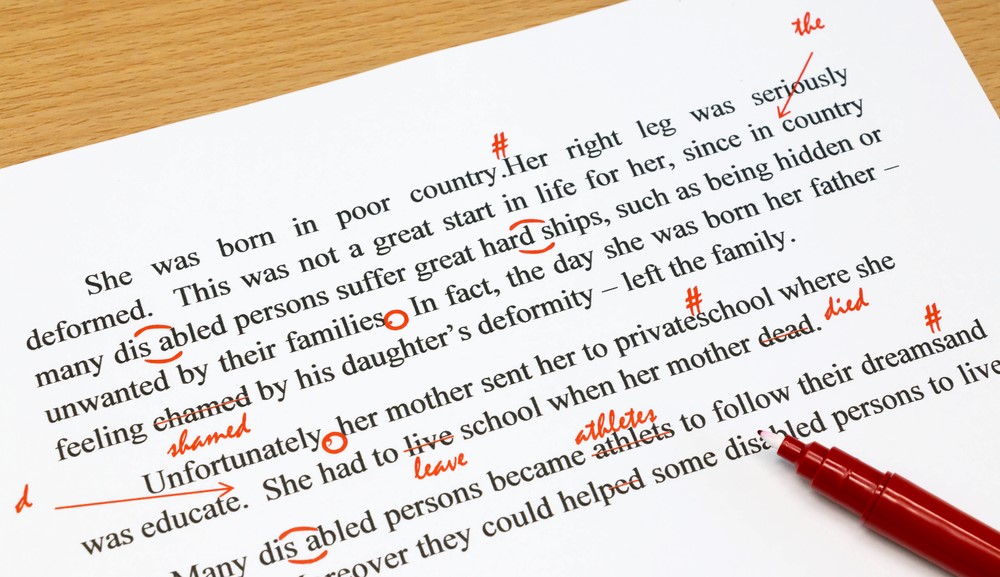You’ve finished the fun part of the writing process, and you’ve had a couple of trusted readers review your book and provide feedback. Now you need to proofread the book to capture all of those quirky little typos, misspellings, and other issues that (if unnoticed) would distract the reader from your story or information and maybe even result in losing their trust as a reader altogether.
Most book printing companies do not proofread your self-published book before printing it, so to avoid embarrassing mistakes, proofread it before submitting the final manuscript to the printer.
1 – Print Out the Manuscript to Review and Mark Changes On
Several studies have shown individuals proofreading a hard copy manuscript catch more errors than those who edit onscreen. One study showed that people who are proofreading on paper can do it anywhere from 20 to 30% faster than those reviewing the manuscript on screen. To save time and improve your accuracy, kill a few trees by printing it out. (You can always plant a few trees in penance for your waste later.)

Double-space the manuscript before you print it out so there’s room to insert comments and corrections. You must number the pages as well because you never know when your manuscript pages might get mixed up and out of order.
2 – Read the Manuscript Out Loud
This is the best way to catch errors such as missing articles (a, an, the, etc.) and words, typos that spellcheck misses (meaning to type “from” but entering “form” instead), and awkward and confusing passages. Better yet, have a friend read it out loud to you as you take notes. This way you can hear where they get confused or stumble when reading the manuscript.
3 – Look for Passive Constructions
If you remember from your high school grammar days that passive voice sentences are bad (most of the time). The passive construction is a sentence where the object of the sentence acts on the subject. Example: There was a great amount of snow covering the ground. (Passive) A lot of snow covered the ground. (Active). This is just a simple example, but make it a practice to look for all sentences that use linking verbs such as: is, am, are, was, were, be, being, and been (all forms of the verb “be”) and highlight them.
Next, go back and review each of the sentences with a verb underlined and see if you can rewrite it in an active form. You should identify and rewrite a good percentage of these sentences to make them stronger.
4 – Read the Manuscript Backwards
This approach helps when looking for missing punctuation or misspelled words. But also for catching things that you might have missed using other proofreading techniques. Read the last sentence. Then the next to last. And so on, until you reach the first sentence of the manuscript.
5 – Wait a While After Writing Before Proofreading
Writing and proofreading/editing are different processes that use different parts of the brain. If you jump from one task (such as writing) immediately into proofreading, you tend to miss things or “autocorrect” errors in your brain since the writing side of you still knows what you intended to say. Putting it away for at least a couple of hours (a couple of days would be better) to allow you to gain some distance from the project before you go into proofreading mode. This will improve the number of errors you find.
6 – Get Someone Else to Proofread the Manuscript
There is something to be said for “being too close to the work.” Especially if you’ve spent a lot of time writing and rewriting the same pages. Get another person to proofread the manuscript for you. They will see it with a fresh perspective and catch things you would typically miss.
7 – Review Apostrophes Carefully
One of the most common amateur author mistakes is misusing apostrophes in contractions vs. possessives–the most common example being the use of “your” instead of “you’re” when you are trying to say “you are.” Slow down and look at all apostrophes to make sure you use them correctly in your manuscript.
8 – Use a Red Pen to Mark Up the Manuscript
Using a red pen, or any other bright color, helps you make sure that you don’t miss any of the change suggestions you note on the manuscript. You can easily miss these if you mark them using black ink or pencil.

9 – Look for Words That End with the Suffix –“ly”
Words that end in “ly” are indicators of adverbs, a typically unnecessary modifier to verbs. Most of the time adverbs can be eliminated by choosing a stronger specific verb. For example – Ran quickly vs. Sprinted. Which one paints a clearer picture in your head? Use the “Find” feature in your word processor and highlight all of them. See if you can remove at least some of them. Also look at empty words that try to “intensify” verbs such as “much, more, very, less,” etc. You can eliminate these most of the time.
10 – Confirm That You Use Homonyms the Correct Way
Homonyms are words that sound the same, but are spelled differently, and have completely different meanings. When you are deep within the writing process, it is easy for your brain to enter the word that sounds like the word you meant. Imagine how embarrassing it would be if you sent out an invitation to “Meat the Parents.”
11 – Proofread During Periods of Focused Attention and Concentration
You should not save proofreading tasks until the end of the day when you are tired from doing other concentration-heavy tasks. You also shouldn’t try to do it while listening to a podcast, sitting on a conference call, or watching TV either. Proofreading requires deep concentration to do a good job, so limit your distractions and only proofread during times when you are very alert.
12– Turn the Manuscript Upside Down
This technique doesn’t work for everyone, but for those who like it swear by it. Turn your manuscript upside-down, face up. This requires you to slow down when reading each word and decipher it. This makes errors stand out.
13 – Make Multiple Proofreading “Passes”
This method of proofreading is time-consuming but works well. Only look for one issue at a time when you proofread the manuscript. For example, you review the manuscript once only looking for punctuation errors. Next, you go through the manuscript looking for homonym issues, then go through it again looking for passive voice construction, and so on. Reviewing the document multiple times assures that you plenty of chances to catch mistakes.
14 – Use Spellcheck, But Don’t Rely on It
Spellcheck does not catch wrong words that are spelled correctly because of a mistyped letter. (See Tip 2 – Read the Manuscript Out Loud for an example)
15 – Fact Check Carefully
Any time you quote someone, make sure it’s accurate and you know the source. Any time you use a figure or number, double-check it for accuracy. Confirm that the names of people, businesses, and products are spelled correctly. Make sure you cite all of your sources, providing links where applicable.
16 – Use a Checklist
Pilots go through a checklist before every flight. Doctors verify each step on the checklist before each surgery, so you should also use a checklist. Especially if you are writing several documents or one long document. It is easy to forget the spelling of a character name or a person of interest in your study. Use checklists to track these mistakes, especially those you make often. Include your commonly misspelled or misused words on the list and any other important project information on the list as well.
17 – Don’t Edit While Writing
Writing and proofreading need to be completely separate processes. While writing it is tempting to make corrections and tweak the wording but try to get a draft down on paper first and then (after observing Tip #5) proofread the manuscript when you are in a completely different mindset.
Following these tips will make you an excellent proofreader. Never underestimate the importance of a good proofread to make your book the best that it can be.
InstantPublisher is Your Premier Book Printing Services Provider
When your book is ready to be printed, have InstantPublisher take care of it. We offer many additional services such as custom book cover designs, different binding and formatting options, and much more. If you have any questions at all, please give us a call at 1-800-259-2592, fill out our online contact form, or send an email to questions@instantpublisher.com.
